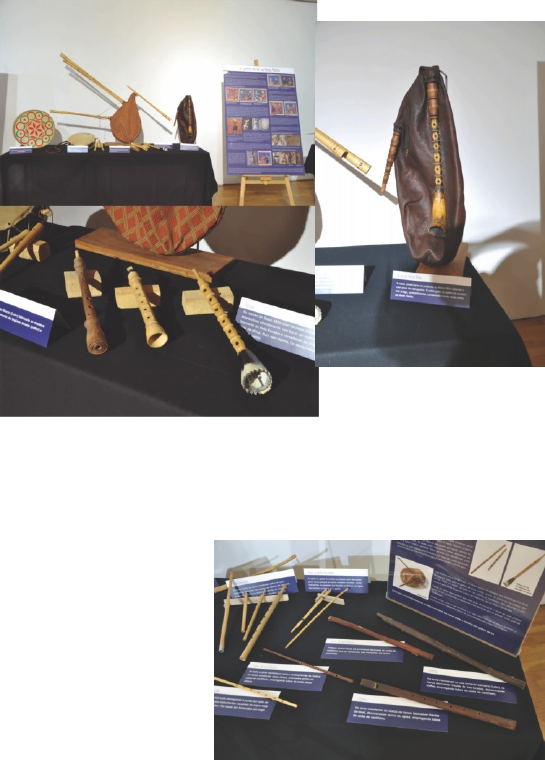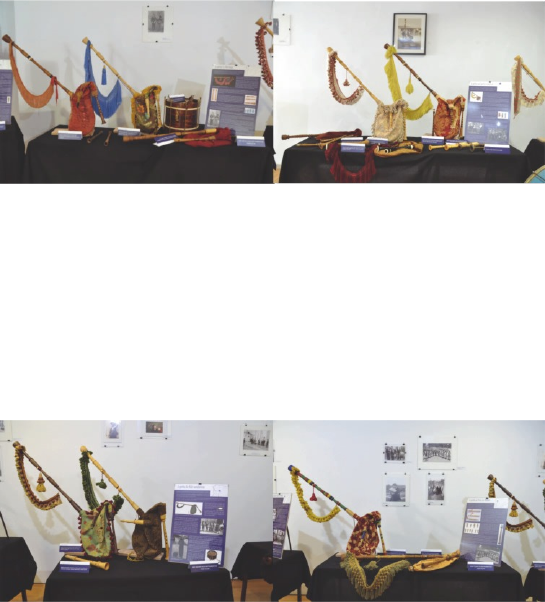The Bagpipe Society
Iberian and Balearic Bagpipes, a new exhibition
An exhibition by Rosa Sánchez and Pablo Carpintero
Rosa Sánchez and Pablo Carpintero are musicians and musical instrument makers and over the last thirty years they have visited all the locations in the Iberian península where the bagpipe is present, including Balearic Islands, with the aim of interviewing and recording female singers and bagpipers. They have now collected more than 700 hours of field recordings that form the main source of bagpiper’s repertoires from the peninsula: 165 bagpipers recorded. Also, they have registered more than 300 historical bagpipes and they have built accurate reproductions of many of them, gathering together a collection of originals and their reproductions. Additionally, they have studied and reproduced many of the musical instruments used by women to accompany their songs.

They have now created an exhibition where they present a journey through bagpipe history as well as an explanation of differences among the cultures that currently use it in the Iberian Peninsula and Balearic Islands.
This exhibition contains replicas and historical originals of more than 40 different bagpipes, as well as numerous percussion instruments which accompanied them, with a special feature on those used by women. It contains a series of 30 explanatory posters, where bagpipe history and the specific characteristics of the different Iberian bagpipes and cultures are explained.
A bit of history
Bagpipes were born, probably around two thousand years ago, when a bag was added to directly blown instruments that were employed across Eurasia such as the Greek aulòs or the Ur pipes, both of which have been reproduced by authors for this exhibition. In this primitive stage, the bagpipe remained hidden within the Eurasian and North African shepherd cultures. However, as iconography shows, the bagpipe underwent significant development in the medieval Iberian peninsula with the appearance of a large number of different varieties, some of which have stayed with us.

What we show
This exhibition is divided in five parts: the first explains the bagpipe origins from the ancient direct blown instruments, which is shown using a number of different primitive pipes and bagpipes from Galicia and North Africa, as well as some types of medieval Iberian bagpipes.
In the second part, we show how the Galician boys repeated the bagpipe history in the sequence of musical instruments that they used to arrive to adult bagpipe: from single straw pipes, through the instruments blown directly with the mouth, as elder or reedpipes, and finally adding a bag to it, building a kind of primitive bagpipe. (see Pablo’s articles in Chanter Spring & Summer 2018)

The third part explains bagpipe making, showing a process that has not varied substantially changed from the Middle Ages until the 20th. We show the ancient tools that old craftsmen employed, explaining the process in detail.
The fourth part shows how the instruments that accompanied bagpipes have varied through the time. In the Middle Ages and Renaissance the Iberian bagpipe played alone, with oboes or accompanied by female percussion instruments; we show more than thirty different types of instruments played by women. During the baroque centuries the Iberian bagpipe wasassociated with the tabor-pipe, the XVIII century led to the bagpipe being accompanied with the drum but no flute/pipe. Finally, in the XIX century some popular band instruments, like side drums, bass drums, clarinets, etc., begin to play along bagpipes. All these accompaniment forms are kept alive in the Iberian bagpipe cultures.
The last part of the exhibition shows the diverse Iberian bagpipes cultures that, in these one thousand years, have developed definite characteristics:

-The Cántabra and Asturiana bagpipes.
-The bagpipes from Eo-Navia, a culture between Asturias and Galicia.
-The great diversity of different cultures and models associated with them that can found in Galicia: thegaitas of Terra Cha and thegaita de ronquillo
Chairega, the central Galicia bagpipes, thegaita of ronquillo of the occidental zone, thegaita de catro voces of Arzúa and Terra of Melide and, finally, thegaita of barquín (bellow bagpipe) and the primitiverosca, both from the Baixo Miño.
-We also explore what we know about the Bierzo and the Maragatería bagpipes (León province) and, further to the east, thegaitas de boto from Aragón, the cataloniansac de gemecs and his sister, thexeremies from Mallorca.
-To the south, we found three very interesting and distinct bagpipe cultures: the Sanabresa, the Alistana and the Trasmontana, already in Portugal.
-Finally, we explore the three main portuguese coast zones that use the bagpipe: Entre-Minho-e-Douro, the Coimbra bagpipes and the bagpipes from Estremadura, that reflect the big cultural exchange among Lisbon and Galicia in the XVIII and XIX century.

Each different type is explained through a poster where we describe the main characteristics regarding turning and chanter morphology, fingering, ornamentation, musical scale, reed morphologie, repertoire and accompaniment. There are also more than 70 historical photographs from all the Iberian and insular cultures.
You can see the exhibition pictures at this link: : http://bit.ly/Chanter83 Finally, there are two videos, one explaining the early origins of the bagpipes and their evolution. http://bit.ly/Chanter84 The second shows us playing all the different Iberian bagpipes and drums and explain their differences. http://bit.ly/Chanter85
**Finally!
**We would love to take our exhibition and music to other locations. If you know of a venue that you think would be suitable and interested, please contact me. We need and area of approx. 250-300 m2, some cases or protected tables for the instruments, a total surface of aprox. 50 m2, somewhere for fixing photographs and, of course, good security! pablo.carpin@gmail.com
- Data Processing Notice (GDPR)
-
@BagpipeSociety on X (formally known as Twitter)
-
TheBagpipeSociety on Instagram
-
 BagpipeSociety on Facebook
BagpipeSociety on Facebook
Something wrong or missing from this page? Let us know!
